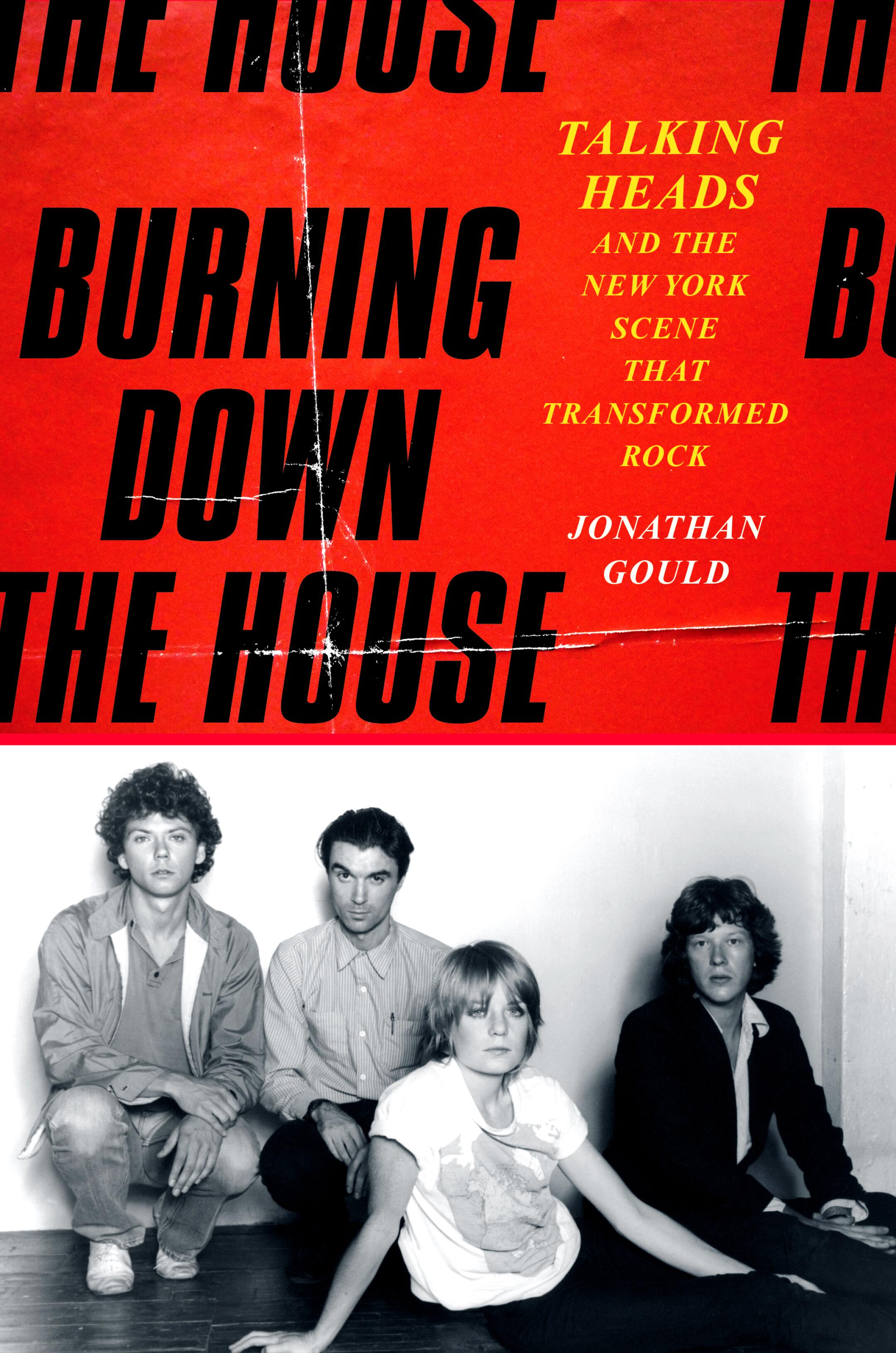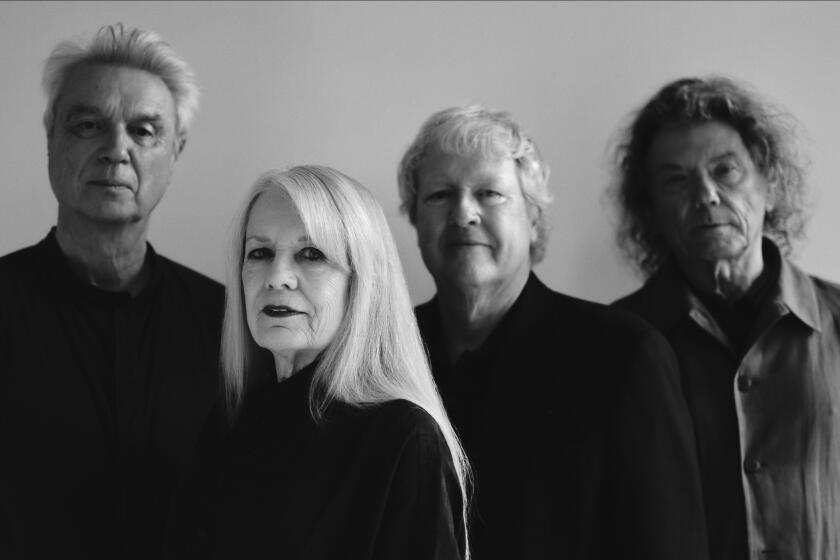In writing a biography about a well-known and significant band such as Talking Heads, where many fans are already familiar with its outline, the focus should be on revealing lesser-known aspects, hidden details, and interesting anecdotes to create a more comprehensive and vivid story. Regrettably, Jonathan Gould’s new book, “Burning Down the House,” mostly neglects this goal, resulting in a poorly structured work filled with repetitive tales, unnecessary diversions, and scant enlightenment but abundant excess weight. The book lacks input from the band members and does not meet the mark as the biography that this influential and significant band deserves.
Fans are aware that three out of four members of the Heads initially crossed paths as students at Rhode Island School of Design in the 70’s, a group of privileged individuals with dreams in art and a lack of clear direction. David Byrne hailed from Baltimore, having dabbled in conceptualist photography and previously played in unremarkable cover bands. It was drummer Chris Frantz who persuaded Byrne to join one such band; Tina Weymouth, Frantz’s girlfriend and the daughter of a highly decorated Navy vice admiral, handled bass duties. They were an unusual band that favored innovation over jamming sessions; their first decent composition evolved into “Psycho Killer,” with Weymouth adding the French recitative in the song’s bridge.

Timing played a crucial role for the upcoming leaders. In October 1974, Frantz leased a roomy loft on Chrystie Street in East Village, not realizing it would serve as their rehearsal spot where the three musicians would perfect their art. The loft was conveniently close to CBGB, destined to be the birthplace of New York’s punk movement and the Heads’ main stage during the early stages of their career.
In March of 1975, the members of Talking Heads – Byrne, Weymouth, and Frantz – witnessed a performance by Boston’s Jonathan Richman and the Modern Lovers at an artsy collective space in Soho called The Kitchen. This show opened their eyes to a fresh way of making music. With his child-like appearance that often drew laughter in high school, Richman left an impact on the band’s preppy aesthetic and inspired Byrne’s distinctive vocal style. Within a year of settling in the city, Talking Heads had developed their unique look, sound, and preferred venue. A chance encounter between Frantz and Modern Lovers bassist Ernie Brooks in a West Village cafe led to Frantz asking about keyboardist Jerry Harrison. Brooks provided his contact information, and soon after, Harrison joined the band, completing the iconic Talking Heads lineup.
After signing a deal with Seymour Stein’s label Sire, the band started working with producer Brian Eno, starting with their second album “More Songs About Buildings and Food.” This collaboration continued with the iconic “Remain in Light,” where Eno took on more responsibilities than just production. He began writing songs with Byrne, which caused tension within the group. When Byrne was accused of not giving proper songwriting credits (the album was listed as “David Byrne, Brian Eno and Talking Heads” instead of individual band members), it led to a rift that persisted despite the band’s success with albums like “Speaking in Tongues” and the soundtrack for the film “Stop Making Sense.” The situation worsened as Byrne took more attention, while other members harbored resentment. Their final album, “Naked,” was less successful, and Talking Heads disbanded in 1991 when Byrne left to pursue other ventures.

Music
Following over two decades of strained silence, the re-release of the iconic 1983 Talking Heads concert film “Stop Making Sense” has fostered reconciliation, potentially leading to even closer connections.

In an intriguing twist, Gould presents the history of the Heads in a book published half a century after their debut at CBGB, a venue that marked the start of their career. Interestingly, while tasked with detailing Manhattan’s late ’70s downtown renaissance, Gould displays a rather dismissive or even disdainful attitude towards many key figures in this scene. For instance, he deems Richard Hell, a significant pioneer of New York punk, as a mediocre artist whose singing, songwriting, bass playing, and poetry were all pedestrian at best. He criticizes Patti Smith’s music as bordering on the absurdity of beat poetry, and he finds the Velvet Underground, a band that laid the groundwork for New York punk, to be limited by their pretensions towards coolness, irony, and immorality. Even Chris Frantz’s drumming is described as unimaginative in Gould’s perspective. Furthermore, Gould tends to use the same descriptive term, “willful,” when discussing various artists, such as Jonathan Richman’s band lacking commercial instinct, the Heads displaying a conventionality on stage, and Johnny Ramone being an annoyingly obnoxious guitarist.

Entertainment & Arts
After a seven-year hiatus, David Byrne returns with fresh tunes! He’s made an announcement about his latest work, which also includes a tour starting in North America come September.
It’s astonishing how one might strive to unravel the mysteries behind one of rock’s pioneering bands, all while seemingly harboring disdain for the very culture that gave birth to it. If you’re curious about gaining a deeper understanding of the creative explosion that fostered the Talking Heads, I’d recommend delving into Will Hermes’ 2011 book “Love Goes to Buildings on Fire.” Regrettably, as of now, a comprehensive biography of Talking Heads, one that fully captures their essence, remains an unfulfilled gap in our literary landscape.
William Mulholland’s ‘Thirsty: California Water, and the Real Chinatown’ was penned by Weingarten.”” or “Weingarten wrote the book titled ‘Thirsty: William Mulholland, California Water, and the Real Chinatown.’
Read More
- Brawl Stars December 2025 Brawl Talk: Two New Brawlers, Buffie, Vault, New Skins, Game Modes, and more
- Clash Royale Best Boss Bandit Champion decks
- Best Hero Card Decks in Clash Royale
- Call of Duty Mobile: DMZ Recon Guide: Overview, How to Play, Progression, and more
- Clash Royale December 2025: Events, Challenges, Tournaments, and Rewards
- Best Arena 9 Decks in Clast Royale
- Clash Royale Witch Evolution best decks guide
- Clash Royale Best Arena 14 Decks
- Brawl Stars December 2025 Brawl Talk: Two New Brawlers, Buffie, Vault, New Skins, Game Modes, and more
- Decoding Judicial Reasoning: A New Dataset for Studying Legal Formalism
2025-06-17 13:34
